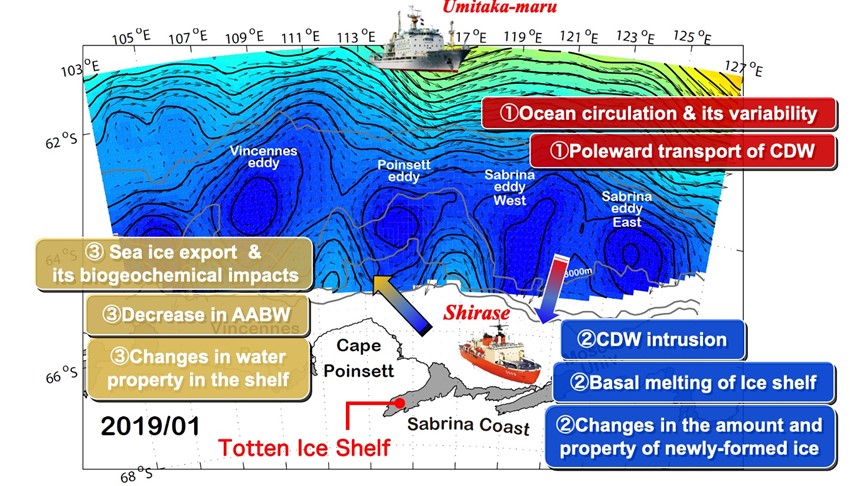The Heart of the East AnTarctic CRyosphere-Ocean Synergy System (HEAT-CROSS)

The Antarctic ice mass loss is now becoming evident not only in West Antarctica, but also in East Antarctica. In particular, the mass loss from the Totten Glacier, grounded well below sea level (i.e., vulnerable to oceanic thermal forcing) with an ice volume equivalent to >3.5 m of sea level rise, has accelerated in recent years. To elucidate the mechanism of mass loss from the East Antarctic Ice Sheet and its impacts on biogeochemical cycle in the surrounding Southern Ocean, we have initiated a 6-year (2022-2028) research project, the Heart of the East AnTarctic CRyosphere-Ocean Synergy System (HEAT-CROSS).
The project began with satellite observations that revealed four standing clockwise eddies with about 200 km scale in the Australia-Antarctic Basin (AAB) that constantly transport warm offshore Circumpolar Deep Water (CDW) in a polar direction (Mizobata et al, 2020). Heat transport by each circulation is estimated to range from 2.6 TW to 11.7 TW (Hirano et al., 2021), but their formation mechanisms and variability of circulation are unknown, and current climate models do not reproduce these eddies. To understand the response of the Antarctic ice sheet to global warming now and in the future, it is an urgent issue to clarify how the CDW originating from the AAB reaches the Totten Ice Shelf via the continental shelf, including these standing clockwise eddies. This project, consisting of three subgroups (each targeting eddies in the basin, coastal ocean circulation and ice-ocean interaction, and biogeochemical impacts), will not only address this issue but will also investigate the biogeochemical impact of freshwater supply and changing sea ice property associated with Antarctic ice mass loss through in-situ and satellite observations and numerical modeling (Figure 1). In the first year of the project, the icebreaker Shirase and the training ship Umitaka-maru were used to successfully conduct hydrographic surveys, deployment/recovery of mooring systems, phytoplankton/zooplankton/marine snow samplings in the AAB and around the Totten Glacier. We have already begun preparations for the next observation (December 2023-February 2024). We already have some new research results, which will be presented here when they are printed.
1Department of Ocean Sciences, Tokyo University of Marine Science and Technology
2National Institute of Polar Research







